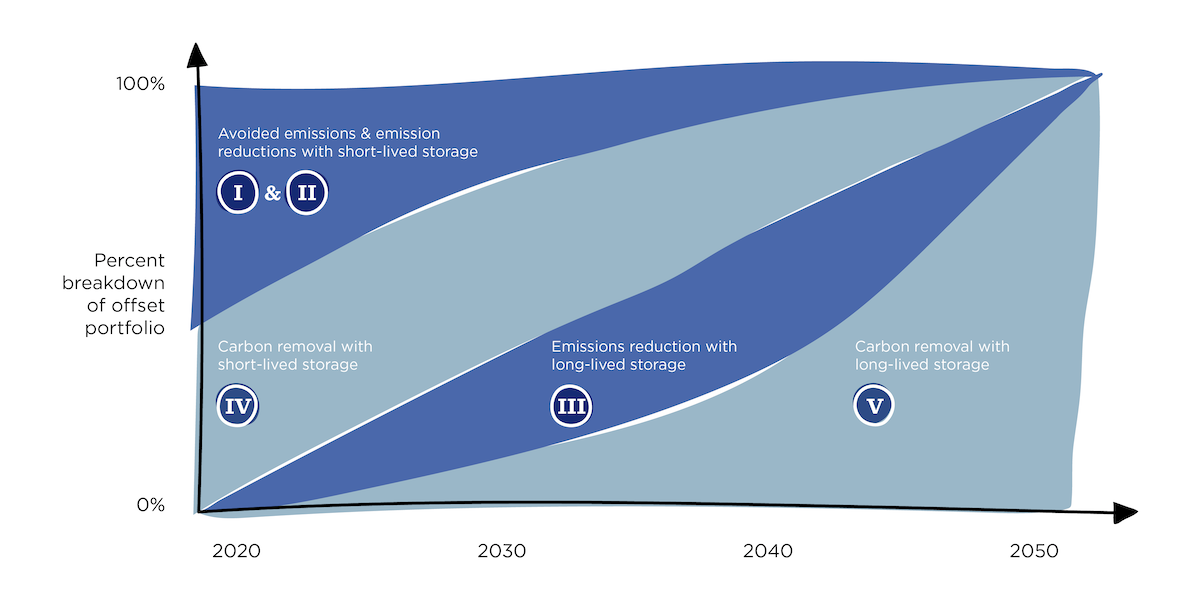Removing IDEO’s emissions with voluntary carbon offsets

“Genuine question: are offsets a useful thing?”
That was the question that we woke up to from our colleague, EJ Baker, on IDEO’s #climate Slack channel in mid-September. For months, Anna Varnai, Jenny Gottstein, Mike Sakowski, and I had been evaluating potential providers and projects to offset IDEO’s carbon footprint in our journey to becoming Net Zero.
EJ’s inquiry brought us back to a question we had been debating for months: Is it better to invest in voluntary offsets or invest more deeply in reducing emissions? While there are legitimate arguments to be made for each path, we felt that emissions reductions weren’t enough. We urgently need to remove greenhouse gasses from the atmosphere. And since we are driven to design the world we want to live in, we chose to meet in the middle—both reduce our emissions and offset what we are unable to reduce. Despite its limitations, offsetting offers a way to strengthen our climate commitments as we ramp up our emissions reduction efforts.
In principle, voluntary carbon offsets appear simple; in reality, they become complicated very quickly. We reached out to offset providers and offset purchasers to learn about their approach and experiences, but instead of walking away with clarity, we realized that no one had really figured it out yet. Even the experts were still grappling with questions like what types of offsets should be used and when, or whether offsetting is even a credible means of achieving Net Zero.
In search of answers, we set out on a quest—diving into academic literature, researching industry best practices, and following countless startups in the space. We learned about the permanence, additionality, and vintage of an offset and how each relates to the quality of an offset project. We learned about the potential social benefits—from community employment to energy access—that come from different projects. We learned about the entities that verify and certify offset efforts. And, we learned that the more we uncovered, the more questions we had.
Should IDEO invest in high-quality and expensive carbon sequestration solutions aligned with our ambitions for the future? Or should we invest in readily available and affordable nature-based solutions? How much geographical representation should we have? How do we know that our investments won’t go up in smoke? How should we think about the intersection between our offsets, climate justice, and IDEO’s DE&I commitments?
The considerations for what to invest in went on, and the dilemma was paralyzing. On the one hand, we wanted to do it all. On the other hand, we had a finite budget and the clock was ticking. What was the right way to get started?
We contemplated having employees vote and help us pick offset projects. While this approach empowered employees to directly shape our company investments, in an area as complex and opaque as the voluntary carbon market, it would be hard for all participants to have an informed perspective in voting.
We contemplated creating a committee that would select projects based on a set of established needs and values. While simple in practice, we weren’t confident an internal team could navigate the magnitude of the task in a manner that fully represented IDEO, and the inevitable scrutiny that comes from decisions like this.
We contemplated seeking advice from third-party experts, but found that many of them sold offsets themselves, raising all kinds of questions about their motives and whether there was a conflict of interest (even though they were extremely generous with their perspective—thank you!).
We needed to get reasonably smart about this space to make informed decisions.
Enter the Oxford Offsetting Principles, a series of guidelines put together by Eli Mitchell-Larson et al., that outline how offsetting should be approached to achieve Net Zero. Informed by these principles, we were drawn to two start-up offset providers, Lune and Patch. These providers stood apart for several reasons. First, they allowed us to select a broad portfolio of high-quality carbon offset projects. Second, their projects had an international reach. From the get go, we knew we wanted our carbon offsetting efforts to reflect IDEO’s global presence, impact, and responsibility. Both Lune and Patch offered a way for us to do so.
From there, having estimated our carbon footprint at around 4,950 t CO2e for 2021, we intentionally over-offset our emissions by purchasing 5,500 t CO2e.

Based on the Oxford Offsetting Principles, we spread those offsets across:
- Global renewable energy projects for Type I (22.5%)
- Forestry protection projects in Asia and Latin America for Type II (22.5%)
- Methane capture at landfills in the United States for Type III (5%)
- Reforestation projects in Africa and North America and regenerative agriculture projects in the US for Type IV (45%)
- Enhanced weathering projects in Europe for Type V (5%)
Overall, we spent a little over $20 per tonne of CO2e with about 92% of those fees going toward the projects themselves. (You can see a visual breakdown of our project bundles with Lune, here.)
Are we confident that our offset strategy is the gold standard? Not quite. But we do feel confident in our approach, and as the voluntary carbon market matures, we will continue to iterate alongside it. We’ve learned that climate action, like design, requires us to get started with curiosity and humility. It demands a learning mindset that seeks progress over perfection.
To those who have purchased or are considering purchasing offsets of your own, we’d love to hear about your approach and what you’re learning.
This article is part of a series detailing IDEO’s journey to becoming Net Zero, the lessons we’ve learned, and our continued commitments to addressing climate change.
Words and art



Subscribe

.svg)









